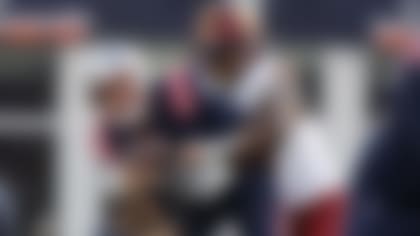The bulk of ߣĎČÉúAV roster reconstruction is behind us. The schedule is out. Yes, kickoff's still four months away, but it's high time for 2021 season forecasting. With that in mind, I wanted to explore the league's top offenses via projected win share.
Remember, win share measures each player, position group and side of the ball's ability to earn/prevent first downs, points and touchdowns. All rosters used to simulate the season in this exercise are the forecasted 53 as of May 18.
Another important preamble note: These are average results. Some offenses have great upside, but their projections are extremely volatile, leaving them just outside of the list below, in the 11-15 range. (SEE: The Panthers and Dolphins, both of whom have the potential to land in the top 10 IF their quarterback play is up to snuff. Or the Bengals, whose suspect offensive line will be the deciding factor.)
Lastly, don't forget that football is complementary. Thus, a few playoff-caliber offenses could miss out on a top-10 spot because their defenses are so strong that they change game scripts to more conservative outcomes. The opposite is also true: Some teams with poor defenses could field a top-10 offense because the unit has to work so hard -- for all four quarters -- to overcome a leaky D.
Alright, enough dilly-dally -- let's get to it! Here is the countdown of my top 10 offenses, based on updated win-share projections:
I was a little surprised that the Titans remained on this list, considering the departure of offensive coordinator Arthur Smith, a decrease in overall pass catcher potential (the Josh Reynolds addition provided a slight uptick, but not enough to address overall WR/TE depth issues after the departures of Corey Davis and Jonnu Smith) and an improved defense. However, the combination of RB Derrick Henry, WR A.J. Brown and QB Ryan Tannehill, along with the healthy return of LT Taylor Lewan, keeps the Titans ranked in the top five in projected yards per play (a category in which they ended up fourth last season at 6.15). This is due to strong run-game potential (they ranked second in 2020 at 5.16 yards per rush) and a low forecast in the turnover department (Tannehill had a 1.5 interception rate last season, ranking fifth among QBs). Brown had 11 touchdowns last season and meets or exceeds that in 59.2 percent of simulations. Henry, who became just the eighth player to eclipse 2,000 yards in 2020, hits or exceeds that monumental number in 55.3 percent of simulations. And he matches or exceeds his touchdown total from last season (17) in 57.1 percent of sims.
With the offseason additions at the skill positions (A.J. Green,&˛Ô˛ú˛ő±č;Rondale Moore, even James Conner) and along the offensive line (including the surprising acquisition of center Rodney Hudson), the Cardinals created the opportunity for Kyler Murray to take a big step forward in his third ߣĎČÉúAV campaign. Between Years 1 and 2, Murray's ability to throw off platform (as in, when he wasn't set and therefore not using the most optimal throwing base) increased in accuracy by almost five percent; he completed 55.8 percent of such throws in 2019, before posting a 60.5 mark in 2020. In 2019, Arizona's rate of sacks per pass attempt ranked 25th (9%), but the Cards jumped to eighth (5%) in 2020. This was more a function of Murray's growth -- as well as the addition of superstar wideout DeAndre Hopkins -- than O-line metrics. But with the aforementioned additions this offseason, Arizona's third-down percentage (39.6, which ranked 21st) figures to improve.
Fun fact: I measured next-play success rate after a sack, hit or pressure contact. Success is defined by gaining 4 yards on first down, half the distance on second down, converting on third down or converting on any down. In this area, Murray's success rate jumped 35 percent from 2019 (21%) to 2020 (56%).
Don't sleep on the Vikings this season. The addition of Christian Darrisaw with the No. 23 pick last month addressed a real problem that matters for this style of offense and how Kirk Cousins executes it. Minnesota ranked 23rd last season when it came to its rate of sacks per pass attempt (7.6%). Basically, when defenses had a good sense the Vikings were passing, pressure increased and Minnesota's efficiency went down. One way to see this is that the Vikings ranked 16th on third down (40.9 percent conversation rate) despite having the third-most earned first downs per game (23.9). With a rushing average of 4.9 yards per attempt (fourth in the ߣĎČÉúAV) and a passing figure of 8.3 yards per attempt (second), the Vikes were creating the right opportunities and making the most of them, just not keeping the sequencing efficient enough.
Fantasy side note:&˛Ô˛ú˛ő±č;Justin Jefferson, who scored seven touchdowns in a prolific rookie season, hits paydirt nine-plus times in 58.9 percent of simulations.
This roster is well-suited for the game plan we've seen Kevin Stefanski install and Baker Mayfield execute. As of right now, Cleveland's offensive line projects as my top-rated OL unit, while the Browns also forecast to get the most production out of any RB group. Even their third-round selection, WR Anthony Schwartz, moves the needle. Oh, and they get Odell Beckham back.
My favorite untraditional metric here relates to playbook and personnel continuity for Mayfield, who forecasts to improve his pace control. What do I mean by pace control? A quarterback's ability to control the time between each snap. I talked to a number of coaches about this concept this offseason, because it is one of those "you can see it" things. So we came up with this standard: In the two seconds before the snap, if more than one non-QB player rotates his head more than 45 degrees, then there's "confusion." I tested this out on three seasons of data (that's how I got to the time and degrees of movement). There are some outliers, but it is a good framework from which to start. So I measured how much this happened last season. Each game, the Browns got better and better pre-snap, resulting in a 20 percent lowering of pre-snap potential confusion between Weeks 10 and 17 (after their bye). Looking toward the upcoming season, Baker figures to be able to use pace and time between snaps to his advantage.
I have the Falcons slated for 7.4 wins, which means they'll be spending a lot of time overcoming the combined 1.59 wins added from defense and special teams. Last season, Atlanta ranked 26th in red-zone offense (53.5 TD percentage), despite finishing 10th in third-down percentage (43.9) and earning the ninth-most first downs per game (22.9). Adding first-round TE Kyle Pitts (and even third-round OL Jalen Mayfield) drives an uptick in red-zone potential. And remember, Arthur Smith is now drawing up the plays in Atlanta; his Tennessee offenses ranked second in 2020 in red-zone percentage and first in 2019 (over 75 percent in each season). Pitts scores six-plus touchdowns in 58.9 percent of simulations (think of anything over 55 percent confidence for a rookie as great). Calvin Ridley notches eight-plus TDs in 60.1 percent of simulations, while Julio Jones does the same in 58.9 percent.
Unlike the Falcons (or Cowboys just below), the Bills' offensive ranking takes a little dip in win share because of the balance with the defense. I have 11.1 wins projected for Buffalo, so 5.1 for defense and special teams. It's better to be more complementary like this, which is why I'm high on this team overall. The Bills are playoff-bound in my projections, with the second-highest overall win total in the AFC.
My favorite notes from the Bills' offense? They project to remain top four in passing yards per attempt (they ranked fourth last year at 7.8), top three in third-down conversion rate (they were No. 1 last year at 49.7 percent) and top five in first downs per game (they were tied with K.C. for the most with 24.8). Along with improvements to Buffalo's defense, it's likely we see the masterful Brian Daboll keep a very efficient offensive game plan, but it looks like they're going to control the pace a little more with increased concentration on the ground game. Bringing in Matt Breida -- and having six backs on the roster right now -- seems to indicate a focus in this area.
The 2021 Cowboys are extremely lopsided, with a win-share projection of 6.03 on offense and 2.97 on defense/special teams. With Dak Prescott returning from a major injury, Dallas has a risk at the backup QB position (Cooper Rush and Garrett Gilbert). And the 'Boys also have concerns along the offensive line. While Zack Martin forecasts to be my second-highest-rated guard (top RG, but second overall among guards to Colts LG Quenton Nelson), the line as a whole sits outside of my top eight ahead of camp, where we'll get a better look at the unit's status.
Yes, this projection is obviously contingent on Aaron Rodgers staying in Green Bay. And with all the recent talk about Rodgers' value, I spent a lot of time digging into unique attributes and data points around the reigning league MVP that aren't listed everywhere or super obvious. Here are three that I really like ...
First, Rodgers is masterful with pace. There is almost no predictability with Rodgers when it comes to time between plays (time to break a huddle, how long it takes for him to yell the play at the LOS). A lot of teams have tells with pace, especially in two-minute offenses and the red zone, which happen to be really important areas. Think of it like this: If the defense gets even three more seconds to know what you're doing based on what is happening right before the play starts, that's a big advantage.
Second, Rodgers does a spectacular job of resetting to throw when he's on the run. I measured how long it takes a QB to get set (on-platform, balanced for the ideal throw) after running (anything beyond a seven-step drop), and Rodgers got into position at the third-highest rate in the league over the past five seasons (54.3 percent), boasting the best passer rating on such throws in that same span (111.3).
Third, I looked at passing downs where a quarterback attempted to complete a throw to a closely defended pass catcher (3 feet of cushion or less) on sequential downs. Guess who earned the most first downs or touchdowns by completing either the first, second or both such passes in 2020? Mr. Rodgers, at 67.4 percent (average of QB Nos. 2-6 in this metric: 62.5). Davante Adams and Aaron Jones both helped drive up this value with top-five or better on- and off-ball impact ratings on sequential closely contested passing attempts.
The Chiefs' rebuilt O-line and uncertainty at wide receiver in terms of depth (it appears they have 14 WRs on the depth chart as of right now) are the two factors that contribute to them finishing just shy of the Bucs in this exercise. Patrick Mahomes, Tyreek Hill and Travis Kelce do combine for the highest QB-WR-TE win-share trifecta in the league, though. I was kind of joking about WR depth, but also kind of serious. With Sammy Watkins now a Raven, Mecole Hardman and Demarcus Robinson will be tasked with playing a bigger role. They both had slightly lower off-ball impact numbers in 2020 than they did in 2019, which means they weren't drawing coverage that created more space for their teammates as often. However, with time comes space, and the new O-line forecasts to give Mahomes more time to operate.
Tampa Bay's offense and defense both account for at least 5.9 projected wins (their win total is 12.2). In the past five seasons, balanced teams -- where the final actual win-total attribution at the end of the season was no more than 0.4 wins different between offense and defense (and a team won at least eight games) -- all made it past Wild Card Weekend. Interestingly, none of them ranked No. 1 on either side of the ball in win share. The Bucs, who return all 22 starters from last year's championship squad, have the best win-share projection on offense and third-best mark on defense.
Fun facts: In games with left guard Ali Marpet in the lineup last season, Tom Brady enjoyed an average of 0.3 seconds longer in the pocket on passing downs. Meanwhile, backs who ran to his side of the line (the gap on either side of him, behind him or to the outside of the tackle on his side) earned 1.3 more yards per attempt than when he wasn't playing.
Follow on Twitter.






















